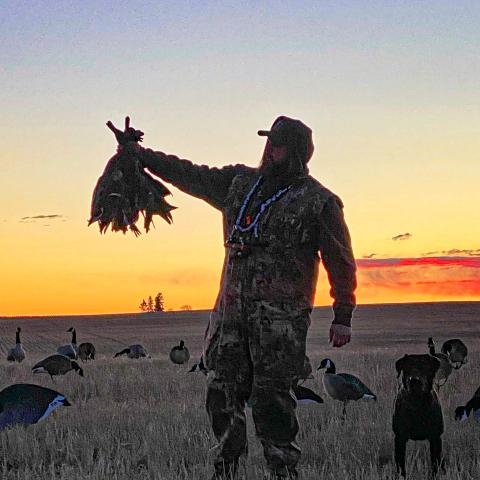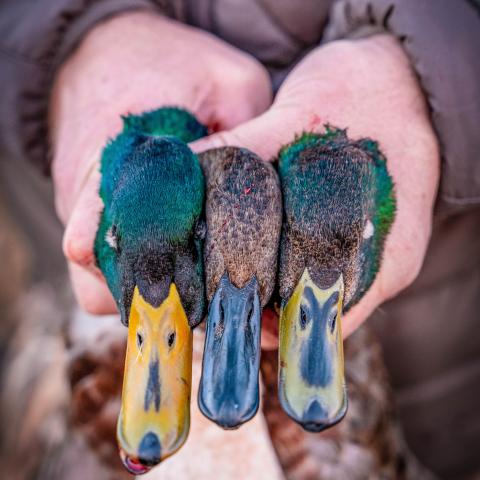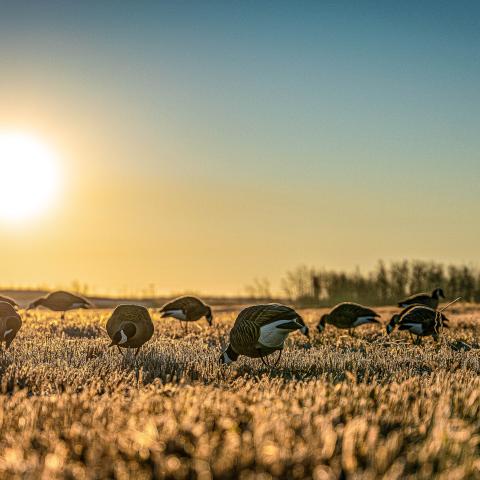A Frosty Finale
The end of the waterfowl season was quickly approaching. Old Man Winter transformed tranquil duck ponds into hard skating rinks. Early morning rendezvous in the field meant heavy layers of frost on the ground. If we were not duck and goose hunting, someone might have complained that it was uncomfortable. Good gear was essential, and nobody stood around watching, as the best way to stay warm was to work hard.
Straggling big honkers are common in migration, and we found a hidden field loaded with long necks and white cheeks. The birds concentrated along a fenceline on the back of a bale yard. We couldn't have asked for a better situation. The birds had fed in the field all fall and the only groceries left were on the outer reaches of the area. We had the perfect wind to set up along the fence, with the bales breaking our outline and providing additional cover.
We created a morning assembly line spraying decoys with windshield washer antifreeze and having another person towel it off. The thin layer had proven effective in preventing frost from forming on our decoys for the length of the hunt. With frost-free honkers ready to attract the real McCoy, we strategically placed our rig to draw the birds directly to us in the early morning light.
We were not disappointed. As the eastern sky brightened, the sound of Canada geese filled the sky. The challenging weather meant the birds were eager to eat. The first flock centered on our decoys like they had all week and muscled up to get to the ground fast. With five shooters, the barrage of steel shot took its toll. Our favorite four-legged companion was out of the gate and retrieving like he hadn't seen a bird all fall. The young black lab wagged his tail like a metronome while trying to balance the big birds and knowing there were more to retrieve.
Mayhem ensued the next half hour as we were inundated with flock after flock of giant birds. The decoys and blinds were so natural that they seemed overly inviting. The geese did not act like late-season birds that were often afraid of their own shadow. The birds had fed along the bales all week. They were not concerned for the objects and likely enjoyed the agricultural windbreak. One flock of honkers flew so close that we dropped several birds into the bales behind us. It was a unique retrieve, hopping between giant round bales and searching the crevasses below for birds.
We had our limit of birds on the ground and enjoyed the rising sun's warmth as it tried to burn the frost off the stubble. The weather outlook was not promising, but we still had a few days left to enjoy time afield.
The following day we were in a large barley field where thousands of geese had been put to bed the evening before. We situated our blinds against a slough bottom with tall grass to take advantage of the natural-looking cover. With our decoys spread out on a large flat area in front, a couple of spinning wing mallards strategically filled the hole. We were anxious for another morning of giant birds.
The predawn light saw strings of mallards line the horizon. We saw a handful of ducks the day before, but they were there by the thousands on that day. We emerged from our blinds to try and pick out the greenheads dressed in their finest attire. A flock of close to 200 birds made one spin around our setup and cupped their wings for a speedy landing. One would think that with 200 ducks spinning overhead, it would be easy to pick out the drakes, but whenever my Benelli found green, someone eyed it before me. A couple of drakes breaking to the right were finally targets that kept flying—momentarily.
The ducks showed up as though choreographed for our entertainment. They dipped, dove, and spun circles over the decoys looking for a place to land. There was a shootable duck every 60 seconds or less. Some of the most extensive flocks we had witnessed all year held nothing back, practically charging into the decoys.
We had come for a honker shoot, but the ducks stole the show. We spent the morning in our blinds, taking photos and picking up after the hunt, and never saw a big flock of geese. Being late in the season and cold weather gripping the country, they had left during the night. Thank goodness the ducks' exhibition would provide memories for another year.
We drove back to camp, and most of the water that had been open the day before was not solid ice. Strings of birds could be seen in the sky heading south. The end was near. We had hoped for more goose hunting, but with the incredible duck action, it was hard not to let them take center stage.
That evening we watched thousands of mallards and pintails bomb in and out of a large wetland with connecting beaver ponds. The birds used a harvested pea field as a food source and spun circles over the rolling field. Plans were devised for the morning on what might be our last hunt of the season.
More windshield washer antifreeze was used as we placed the full-bodied mallard decoys and some honker silhouettes. It was getting challenging to force decoy stakes into the frozen ground. We stood our blinds along a treed fence where the sun would come up on the side of the decoys and not straight into our eyes. The sun rose, and we had not seen a single bird. A coyote tried to stalk our decoys, letting us know the antifreeze made them look alive. Another hour passed, but nobody was ready to throw in the towel. The small beaver ponds behind us were frozen solid, and we surmised the big lake being ice covered.
Finally, a small group of mallards made their way to the end of the field. The birds swung by once, then lined up for a quick landing. It did not take much calling to draw the birds to the decoys. The warm shotgun barrel felt good on the fingers. The birds still had wet feet and gave us hope there would be more coming.
The sun was in the sky and trying hard to provide the BTUs required to warm the landscape, but it was like there was no octane for a hot burn. However, the ducks could feel the difference and must have been waiting for what little warmth the sun could provide before leaving their roost. A flock of 50 mallards and pintails swung wide over the field before whistling toward the decoys. The way the ducks decoyed was magical. We emptied our guns and rejoiced like we had never shot a duck before.
I noticed something strange about one of the ducks the dog had in its mouth and jumped out one end of the blind to have a quick look. The young drake was a pintail/mallard hybrid and a bonus to the excitement and success of the morning. We passed the bird down the line of shooters to admire the unique markings and feathers.
Our hybrid intrigue was short-lived when another big group of late-season ducks called back at us. The whistling wings sounded like jet engines descending from high elevation to the runway below. Shotguns roared, and birds rained from the sky. The heavy plumage made the ducks look twice their size. Either the hunting crew was shooting their best after months of practice, or everyone could sense the end was near and wanted to make the most of every opportunity.
We had a firm body count and carefully targeted a few remaining birds to round out our limit. There was an incredible sense of satisfaction shared amongst fellow hunters. It was a mixture of elation after three days of successful hunts and sadness, knowing our hunting days were dwindling, if not over, for the year.
Always eager for hardcore adventure, there would be no regrets. The memories of a late-season foray are always the ones that linger into the next season. With success measured in many ways, we would be ready to hang up our favorite smoothbores until the next time.





